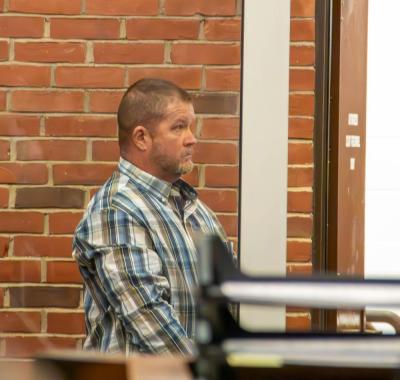‘Intent’ is issue in hearing on explosion charges
In court on Thursday, Mark Halpin’s court-appointed defense attorney argued that her client’s handling of explosives – which caused an Oct. 3 explosion at his West Wareham home – did not include intent to harm anyone.
Halpin, 50, is being charged with one count of the possession of explosives and one count of the use of explosives with the intent to cause fear or panic after the chemical explosion at his 1 Aunt Maryville Lane home resulted in local, state and federal police, fire and bomb squad technicians responding and spending more than 10 hours removing bomb-making materials.
Halpin was arraigned on Oct. 6 and was back in Wareham District Court on Oct. 9 for a pretrial hearing. In that hearing, defense attorney Kimberly Cronin said he “appeared to be a hobbyist” with fireworks and model rockets. The explosive materials found in his house include materials commonly used in fireworks and model rockets, she said.
Prosecuting attorney Jordyn Carpenter countered that assertion, noting that the Massachusetts State Police Fire and Explosion Investigation Unit reported finding other items associated with the “clandestine manufacturing of explosives.”
Carpenter said Halpin told authorities following the explosion that he was loading a toy cannon and dropped it, which caused the explosion.
However, Carpenter cited that bomb squad technicians said the combination of materials found at the location of the blast did not make sense, and they did not believe Halpin.
Carpenter argued that due to the explosion and the large amount of explosive materials and the tools used to make them found in his house, there is an implied intent to cause harm.
The question of evidence of intent is important in any effort by Halpin to seek release on bail. On the basis of evidence currently before the court, Judge Terese Wright agreed with Cronin that evidence suggesting any intent to cause harm was not present. Although Halpin remains in custody, Wright on Thursday set the conditions that would have to be followed if he were to be released on bail: home confinement with a GPS tracker except for court and medical appointments and a prohibition from possession of any weapons or incendiary devices.
The issue of “intent to harm” will continue to be important in Halpin’s case. The more serious charge of “ secreting, throwing, launching, or placing of explosives.” requires an “intent to cause fear, panic or apprehension in any person, ignite, explode or discharge such an explosive device or substance or release a chemical biological or nuclear weapon.”
To illustrate the lack of intent, defense attorney Cronin used a hypothetical example of throwing a molotov cocktail on the ground with nobody around. She said doing so would be a crime but there is no intent to harm or threaten anyone else.
According to Carpenter, Halpin made the 911 call and was arrested following the chemical explosion. Authorities found him spitting up blood with burns on his chest and cuts to his hand, according to the report.
Several state police and fire response teams, as well as Wareham Police and Fire searched the house where they found the point of detonation in the explosion, otherwise known as the “blast seat.” At the blast seat, investigators reported finding broken windows, warped and melted appliances and debris.
Carpenter told the court that Halpin has been charged with, but not convicted of, gun and fireworks related charges in the past.
Halpin is next due back in court for a probable cause hearing Monday, Nov. 3. He is currently being held on $10,000 bail.































